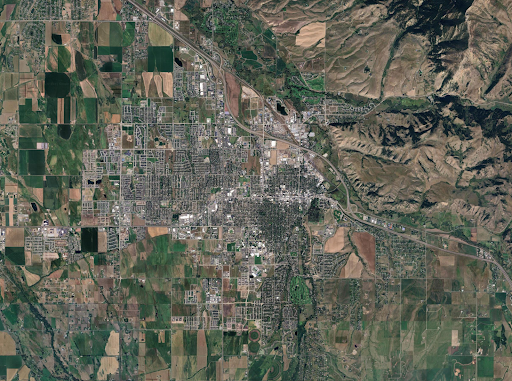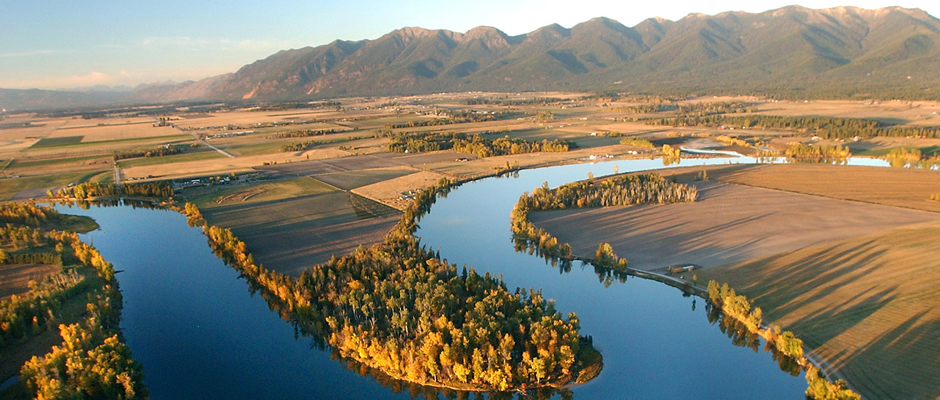By Amy Katz, Conservation Director
(Photo in header of Bozeman Pass by Kestrel Aerial courtesy of Gallatin Valley Land Trust.)
As our land trust members are wrapping up 2025, rushing to close easements and fill final funding gaps to meet year-end deadlines, I have been thinking a lot about the sense of urgency many of us in the conservation community perceive at the moment. We are watching the West grow exponentially, while simultaneously witnessing federal, state, and provincial funding disappear. Our land trusts need to take on more conservation projects than ever to meet the demand of landowners and stay ahead of development trends, yet they also have less funding than ever to engage in this important work.
The opportunity is clear, in this critical time, for Heart of the Rockies Initiative and the Keep It Connected program to play a pivotal role for our members and the landscape.
A review of recent development data in our region reflects the urgency. For instance, between 2023 and 2024, Idaho experienced the fastest growth in housing units of any state in the nation, with the top 10 most populated counties in the state adding over 26,000 residents. Meanwhile, American Farmland Trust is projecting the state of Wyoming will lose over 85,000 acres of farmland and ranchlands by 2040 if development trends continue.
Scale these estimates out to the full Heart of the Rockies Initiative service region and the picture is alarming: we are losing an average of 100 acres to residential development per day, resulting in a total loss of at least 35,000 acres in 2025.
Over the course of that same time period, land trusts across our service area lost $108 million in Regional Conservation Partnership Program funding alone. Meanwhile, landowner demand for easements is continuing to increase, with willing landowners sometimes waiting years to work with a local or regional land trust. Together, these factors capture a palpable sense of demand and urgency that can be combatted most effectively through increasing the access to private funding.
To contextualize this a bit, our Keep It Connected portfolio currently demonstrates a $10 million funding need, and that is only a tiny fraction of the full conservation portfolio of all of our members, who are often juggling a dozen or more projects at a time.
All of this leads me to think: what truly is at stake if development continues at the pace it is going?
As a cartographer, I look for visual representations of this risk. As an example, grizzly bears, black bears, mule deer, and elk move steadily through the north-south corridor in Montana between Bozeman and Livingston, crossing I-90 back and forth to move from the Northern Continental Divide Ecosystem and the Greater Yellowstone Ecosystem (GYE). The below map shows the modeled grizzly bear corridor between the two cities in teal.

Given this is such a critical migration corridor, sprawl from Bozeman and Livingston has the potential to bottleneck animals as they experience an increasingly smaller, more narrow area of open space through which to move.
To visualize how the development and sprawl has changed over the years, we can use the historic maps from Landscape Explorer. Working Lands for Wildlife assembled historic aerial imagery from 1940 to 1970 and digitized it to compare with modern imagery from the last handful of years. Their maps demonstrate the permanence of urbanization, and in areas such as the GYE, the difference is stark.
The images below are of the town of Livingston, Montana: 1948 in black and white, and 2023 in color.


And here are historic and recent images of Bozeman, Montana:


While the images above and the development data reflect what can feel like unstoppable momentum of large-scale loss of connected working lands and habitat in our region, we do have a powerful tool to make a difference for people, working lands, and wildlife. Conservation easements offer landowners the opportunity to continue their generational practices while perpetually anchoring these corridors for wildlife movement in the face of sprawl. And, through the Keep It Connected program, Heart of the Rockies Initiative can accelerate the rate that these easement projects are completed, protecting this iconic landscape and the livelihoods of the people and animals who call it home.


